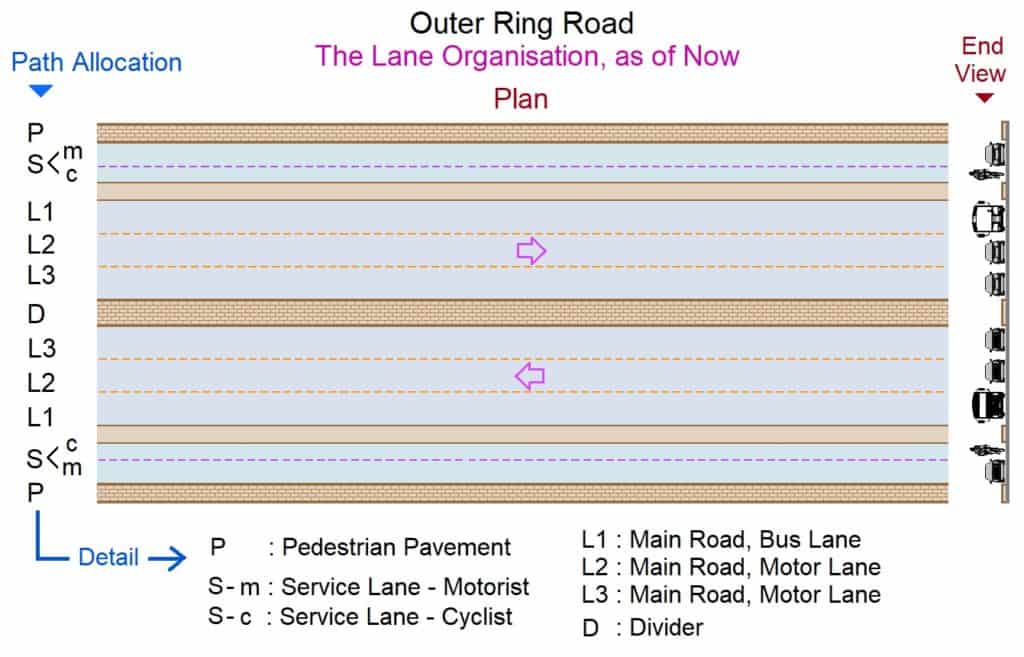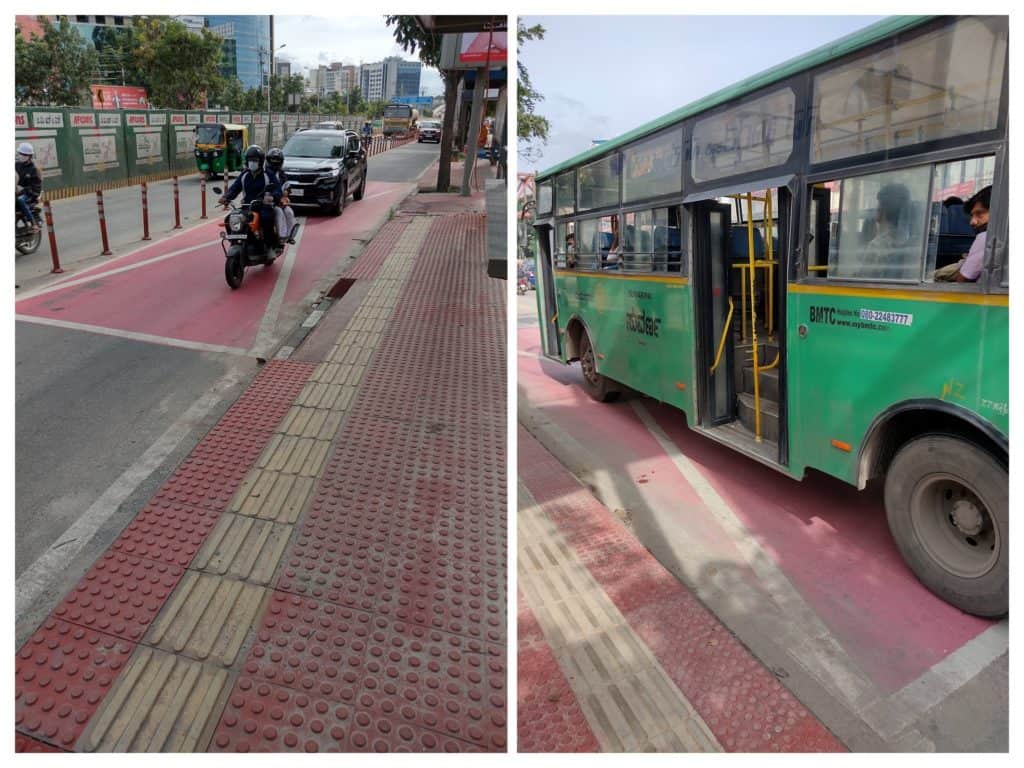Namma Metro construction on Outer Ring Road (ORR) is just starting. If the speed of execution on other lines is anything to go by, the next few years could very well be hell for residents living off ORR.
But it need not be torturous. It is possible for the BMRCL (Bengaluru Metro Rail Corporation Ltd) to follow certain steps to ensure daily life is not inconvenienced while construction goes on. Unfortunately, we have no regulations or guidelines on how to execute civic projects without putting citizens through risk and pain.
Here, though, are some pointers for BMRCL to consider and make changes that will provide significant relief to pedestrians and motorists alike. So BMRCL, can we make the ORR Metro project something to look forward to, even before completion?

1. Cut, not dig
The first thing any agency does, when they start a project, is dig. They pile the debris on the side. This attracts more garbage. Using sparse space for piling debris for months on end, denies pedestrians space to walk, apart from adding to the ugliness of the site, and creating an overall unhealthy and risky environment.
The alternative to digging with shovels, pick axes, or JCBs, is to use cutting machines to slice up sections of roads/pavements, and have trucks ready and waiting to haul away the debris. This ensures that work sites neither impede pedestrian and vehicular traffic, nor create an unhealthy environment.

Read more: A sustainable plan to solve traffic woes at Iblur Junction
2. Ensure the rest of the road is even and smooth
Metro rail construction involves the use and movement of extremely heavy equipment. So, the roads around metro sites, that were built for normal traffic, crumble rapidly. This makes traffic movement dangerous and slow, causing accidents and traffic pile ups.
As an alternative, before commencement of work, BMRCL should re-lay lanes/roads so that these can withstand both heavy vehicular traffic and construction equipment. A metro rail project of several thousands of crores should budget for a few tens of crores for road-relaying.
3 Barricades and protective covers to reduce dust from construction
Though metro work sites are barricaded today, these barricades don’t completely seal the sites off from regular vehicular traffic and pedestrian movement. The quality of the barricade material, design and workmanship need to be improved so that the sites are completely sealed off.
Periodic washdown of work areas may be needed so as to reduce dust pollution. Apartments in the vicinity will be happy to share their excess treated water for this purpose.
4. Pavements and protective barricades for pedestrians
During any construction activity, pedestrian infrastructure is the first casualty. This is true of metro works as well. Pavements are destroyed first. If they are spared at all, they become the site to dispose of unwanted construction material. The footpath thus becomes a disaster zone that threatens pedestrians’ lives.
BMRCL has a better option. If they can create neat, obstruction-free, covered footpaths, fully barricaded from both the construction zone and vehicular traffic, with overhead lights every 10 feet, pedestrians will be able to use footpaths at all times without risking their lives. Commuters may be encouraged to abandon slow-moving cars and autos in favour of footpaths, even. A small, dedicated crew should be made responsible for maintaining pedestrian infrastructure at all times.

Pedestrians also need safe road crossings every few hundred metres (mandatorily at bus stops on ORR) in the form of a High Raised Pedestrian Crossing (HRPC). These crossings should have a covered walkway at the road median where metro work happens.
Metro work should ideally not impact footpaths since these are on the service road, separated from the median by two lanes and the ORR drain. However, we expect motorists on the main carriageway to start using the service road to save time, since only one lane will be available once construction starts.
Besides, the footpaths are not of uniform width. And in some sections, hawkers and small shops have forced pedestrians to walk on the service road itself, which places them at risk of accidents. To prevent this, footpaths should be of uniform width, and open to pedestrians only. A few open spots beside the road, under flyovers, around road crossings etc., can be identified and marked exclusively to support the needs of street vendors.
There is a beautifully laid drain footpath on ORR since 2016 with adequate coverage of 8 ft. width, which is largely free of street vendors. However, the following points need to be addressed, to improve usage by pedestrians:
- Carefully trim tree branches to ensure safe walking
- A gentle step up/down is needed in the sections where service lane entry/exit into ORR main carriageway interferes with this footpath. HRPC style speed-breakers should also be put up at these sections so that vehicles provide safe passage for pedestrians.

Read more: Proposal for a cheaper, efficient Metro line on Inner Ring Road
5. Don’t forget the cyclists
Cyclists in Bengaluru are in perennial danger from rash motorists and bad roads. Namma Metro work zones are even worse places for cyclists to pedal as they are now squeezed into worse roads, competing with more powerful vehicles for lane space.
Cyclists though are natural allies to public rail networks like Namma Metro, if the BMRCL manages to provide them parking bays at stations, or allow them to bring their bikes into metro coaches. During construction phase though, cyclists need to be provided safe passage, just like pedestrians.
Currently there are narrow bicycle lanes on the right-most section of the ORR service road. However, these lanes have not been formally designated so. Hence, two-wheelers (and sometimes the odd auto too) are plying on the barricaded bicycle lane violating the one-way rule of the service road, perceiving this to be a safer option than going against the one-way with risk of collision.
If there is serious intent of facilitating cycle lanes for a city like Bengaluru, proper signage needs to be introduced. And the Bengaluru Traffic Police should use smart cameras and ‘click and post’ mode for issuing challans for violators.

- Pros: There is a dedicated bicycle lane on the right side of the ORR service lane
- Cons: It is used less by bicycles/Yulus, and more by two-wheelers on the wrong side of service lane
BMRCL can tie up with bike rental platforms like Yulu to facilitate free cycles for last-mile connectivity. There must be docking stations next to each bus stop on ORR. To encourage use, commuters can be reimbursed if they return the bike within the circle or a sphere of immediate influence.
6. No compromise on bus lane; provide mini buses for sub-arterial roads
Bus lane will optimise the travel time of commuters who are facing delays and inconvenience on account of metro work and the necessary barricading of one lane of ORR on both sides. But it is not sufficient to just create a bus lane, as illustrated below.

- Bus lane should have an active frequency of buses of the 500 A/ C/ D/ F series, to provide connectivity among the prime IT corridors of Bellandur, Whitefield and Hebbal.
- There are numerous intrusions into the bus lane from riders. The lack of compliance and enforcement is seen as a punishment for law-abiding riders, and has been the biggest source of resentment against the bus lane.
- As in the case of cycle lane violators, traffic police should use smart cameras and ‘click and post’ mode for issuing challans, rather than holding up traffic and aggravating congestion. Check posts can be set up on arterial roads with electronic tagging of vehicles to identify those with unpaid challans, with increased surveillance on weekends.
As a long-term plan, we propose that the right-most lane on both sides of the main carriageway be freed up again. This portion can be barricaded from the rest of the main carriageway, creating bus bays in the centre. The connectivity of existing skywalks can be extended to the centre of the road to allow pedestrians to get to the bus bay.
7. Be kind
Just as the convenience of residents is important, it is necessary for BMRCL to pay attention to the needs of their staff and workers as well.
Activists have found that workers live in tin sheet colonies or makeshift buildings, hidden from public view and dispersed across the city. Living conditions are poor, with 10-20 persons staying in cramped rooms without proper ventilation or access to drinking water, and poor sanitation. The recent incident of the collapse of a building rented out to metro workers was shocking.
It is also a concern that work sites have no safety conditions in place, and workers are expected to work 12 hours a day, seven days a week.
BMRCL must address these, and ensure workers’ safety as construction progresses. Portable toilets/restrooms and container shelters should be arranged for breaks.

8. Work with citizens
BMRCL should form a committee with citizens/RWA (Resident Welfare Association) members, ex-ward committee members, metro officials and BBMP officials. The committee should meet fortnightly or monthly to inspect work sites and ensure all things possible are done to ensure the safety and comfort of road users and address ORR residents’ concerns.
[Ramiah Kumar contributed to this article.]
Who and how does the above points be made to understand and implemented by BM RCL and the contractors who will be appointed. If there is any persons/contractors who can lusten and implement it will be good for everyone.
Just make a diversion road parallel to ORR metro stretch for people to commute. You cant have it working for 3yrs.
This is a script of “what should be”, a normal writing on” what will be”… Is out there, and as always; it’s more about how to burden the citizen.
This is asking for too much!! Nothing will happen if Metro work in Bangalore so far is an example. ORR will be nightmare for next five years. By the time metro starts operation, the vehicle density will double.
Have we ever realised that the traffic congestion will have cascading effect on all connecting roads like Hosur road, Old Airport road etc? Has anyone thought about this and find a scientific solution?